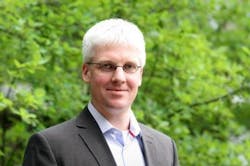KIT's Christian Koos wins 2012 Krupp Prize
Karlsruhe, Germany--This year's Alfried Krupp Prize for Young University Teachers goes to Professor Christian Koos of the Karlsruhe Institute of Technology (KIT). The board of trustees of the Alfried Krupp von Bohlen und Halbach Foundation unanimously decided in favor of Koos, 34, who teaches and conducts research in photonic communication technology. Koos won over 65 other young scientists proposed for the prize, which is endowed with $1.2 million.
At KIT's Institute of Photonics and Quantum Electronics (IPQ) and Institute of Microstructure Technology (IMT), Koos studies nanophotonic components, by means of which communication processes can be accelerated and their energy efficiency enhanced. Using these components, high-performance optical circuits can be integrated on microchips for the transmission and reception of data rates in the order of several terabits per second, corresponding to about one billion telephone conversations. Instead of expensive and rare compound semiconductors, silicon is used for chip manufacture. This element already is an established starting material for electronic and electromechanical microsystems. Its resources on Earth are nearly unlimited.
Koos' work focuses on hybrid integration methods to combine silicon waveguides with organic materials. Optical properties of these materials can be adjusted specifically via the molecular structure. Hence, a large variety of components can be implemented on a single chip. As the waveguides used are extremely small--up to 1,000 times thinner than a human hair--it is possible to accommodate a very high number of components in smallest space.
Research conducted by Koos contributes decisively to reducing the energy consumption of the Internet. Today's information and communication technology already has a share of more than 10% in total electricity consumption in Germany, and data traffic is growing continuously.
-----
Follow us on Twitter
Follow Laser Focus World on your iPhone or Android
Subscribe now to Laser Focus World magazine; it's free!
